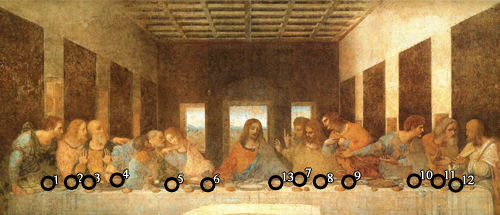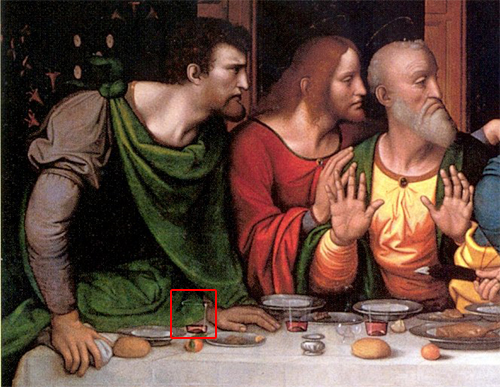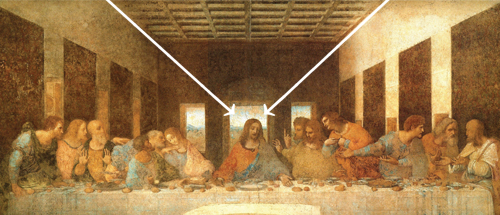Revealing Anagram: The most revealing of codes is in the title of the book and movie rather than in Leonardo’s works. Rearranging the anagrammatic letters of “The Da Vinci Code” results in, “Chance to divide.” Coincidence or divine providence? You decide.
Myth: Leonardo encoded clues of the secret bloodline of the Merovingian Dynasty in his paintings.
Truth: The point of using a code is to communicate a secret without broadcasting to unwanted parties. In order to do this every code must have a key given only to the intended party. For example, in The Da Vinci Code the key to Sauniere’s clue is the Fibonacci numbers, which are placed out of sequence.
13-3-2-21-1-1-8-5 (out of order)
1-1-2-3-5-8-13-21 (proper order)
From this we learn that the message is also out of sequence.
Without a key no one is sure there is a code, nor can the intended party be certain of his decoding. Therefore, if there is a code in Leonardo’s Last Supper there must also be a key within it. Since there is no key in the painting there is no code.
Even in the possibility that there is a key but that it has not been found, how are we to be certain? There is greater probability and certainty that no code exists.
Myth: The figure to Jesus’ right in Leonardo’s painting of the Last Supper is Mary Magdalene.

Truth: Although he looks effeminate the figure is John, the beloved disciple. Many other artists (who are not on the list of members of the Priory of Sion) depicted John and other saints this way. Some of the other saints include, John The Baptist and Saint Michael the Archangel.
An excellent representation of the Apostle John from 1300's to 1500's.
Or
View it archived as pdf (394KB)
This illustrates his youth and meekness, not female identity. For John was truly meek and pure of heart. Biblical examples of his meekness:
- He was with Mary and the pious women at the foot of the cross (John 19:25-27).
- Although he arrived at the empty tomb ahead of Peter he waited, allowing him to enter first (John 20:4-8.
- In the lists of the Apostles he is positioned either, second (Acts 1:13), third (Mark 3:17) or fourth (Matthew 10:3; Luke 6:14).
- Every time his name is written in the gospels it customarily follows his older brother James.
- He prefers to direct attention to Jesus rather than himself. In his own writings he refers to himself as the disciple who Jesus loved, instead of by his own name.
Myth: Jesus’ cup is missing from the Last Supper painting because the Holy Grail is Mary Magdalene.
Truth: There are thirteen glasses on the table, one for each disciple plus one for
Jesus. That means there is nothing missing.

The scene depicted is when Jesus tells the disciples that one of them will betray Him. It does not depict the Institution of the Eucharist. This is part of the reason why Jesus' glass does not resemble a chalice. The other part of the reason why the glass is not depicted as a chalice is because Leonardo painted the utensils as they would appear in his own day. Leonardo intended for the monks who would be eating at the refractory where the painting is, to feel like their meal was an extension of the Last Supper. Including common utensils that were in the refractory at the time helped to accomplish this. This is not so much innovative as it is conservative, for it is the duty of a painter of Christian art to encourage the viewer to consider God (this practice descends from iconography).
Leonardo tried to pioneer a dry plaster painting technique that failed to hold the pigment to the plaster almost as soon as he finished it. Unfortunately it leaves much of the image wanting for detail in our time. Below are close-ups of each of the glasses. Move your mouse over each one so that you can see a superimposed outline of each of the glasses.
Cup 13

|
Cup 12

|
Cup 11

|
Cup 10

|
Cup 9

|
Cup 8

|
Cup 7

|
Cup 6

|
Cup 5

|
Cup 4

|
Cup 3

|
Cup 2

|
Cup 1

|
The only one of the thirteen glasses, which is at all questionable is the one in front of Bartholomew. But since it has wine in it we can identify the bottom half. |
Cup 1

|
One of the ways we know what the details were is from a contemporary copy (pictured below) that is attributed to Giampietrino who was a devotee of Leonardo's work. |

Myth: The focal point in Leonardo’s Last Supper is a “V” shape.
Truth: The “V” shape is the result of making Jesus the focal point. It is created by what artists term as negative space. In traditional art like Leonardo’s Last Supper negative space is never the focal point because it would mean that the painting is about empty space. Look at the painting below and you will see that the perspective lines converge at the vanishing point, precisely on Jesus.

Incidentally, perspective is one of the things that makes this painting important in art history.
Myth: John and Jesus are painted using red and blue to express the equal opposites, yin and yang.
Truth: While John and Jesus may appear to be painted with reversed blue and red colors this does not express yin/yang because blue and red are not opposites. The opposite or complimentary color of blue is orange and the compliment to red is green. Additionally blue and red are part of a set of three primary pigments. The colors of yin and yang must be black and white because they are exclusively diametric. Additionally, Jesus and John are shown wearing their tunics over their left shoulders. If these figures were truly meant to express yin/yang everything about them would have to be equal and opposite. Lastly, Jesus and John are not the only ones wearing red and blue so they cannot be considered a matching pair by this criterion.
Myth: Mona Lisa is an Anagram of the pagan gods Amon and Isis.
Truth: Mona and Amon are anagrammatically matched but Isis and Lisa are not. While the “I” in Isis might look like an “L”, to be consistent with this allusion the second “I” in Isis would also have to become an “L”. There simply is no way to get Lisa from Isis. Leonardo did not even name this painting Mona Lisa. He named it La Gioconda, A derivative of her last name, which means “light hearted woman” and explains her slight smile.
Myth: The perfect expression of PHI in five pointed objects of nature points to the sacred feminine and ancient goddess worship.
Truth: PHI is a number found in nature and most notably in five pointed objects. The number five is also found throughout the Bible: God gave the law to Moses in five books called the Pentateuch. The miracle of the loaves and fishes started with five loaves and ended with five thousand fed (Mat 14:15-20, Jn 6:1-14). The sacred wounds of Christ are five in total. Both PHI and its perfect expression in the five pointed objects points to the fact that nature is a gift for us. It is a witness to the glory of God (Is 6:3).
Myth: Mary Magdalene is a goddess because she carried Jesus’ child in her womb.
Truth: This is a self-refuting argument since author Dan Brown also asserts that Jesus was not divine. Mary Magdalene cannot derive her goddess status from Jesus if He isn’t divine. And if He is divine then worshiping Mary Magdalene in His place would be giving her honor above her position, which is clearly wrong in any court.
Myth: “Sangreal” is translated form Latin: “Sang Real” meaning “Blood Royal”.
Truth: It could not have been “blood royal” because “real” does not translate to “royal”. In that age “royal” was spelled “regalis” or “roial”.
The word should be translated “San” (holy) “Greal” (grail). As early as 1330 the term “greal” appears in Arthurian tales referring to the Holy Grail. Over the following five hundred years the word “san” is combined with varying forms of “greal” resulting in contracted words like: “sangreal”, “sangrayle”, “sangrayll”, “sangraylle”. All of these suffixes indicate that the word does not formally consist of “sang” and “real”. However, the connotation may have been acceptable as a witty pun meaning, “blood real” as in genuine. No matter how you divide “sangreal” the root words support the Catholic position that the cup of the last supper is a real holy cup that contained the real blood (Mt 26:26-29, Jn 6:53-58) of Christ our king and savior.
Source: Oxford Dictionary Vols VI , XIV; Barnhart Dictionary of Etymology; Online Etymological Dictionary; www.etymonline.com
Myth: “In 1975 Paris’s Bibliotheque Nationale discovered parchments known as Les Dossiers Secrets, identifying numerous members of the Priory of Sion, including Sir Isaac Newton, Botticelli, Victor Hugo, and Leonardo Da Vinci.”
Truth: The Dossiers Secrets were fabricated in 1956 and deposited in the Bibliotheque Nationale by criminal Pierre Plantard on October 1, 1975, as part of a hoax to convince the public that he was descended from a royal line. When he revived the hoax with a revised lineage in another set of false documents in 1989 a judge warned him to desist, which he did.
Source: Timewatch: The History of a Mystery, BBC2, 09/09/1996; Priory-of-Sion.com;Catholicanswers.com
I will be updating this website weekly with questions and answers. Please check back again soon.
|


